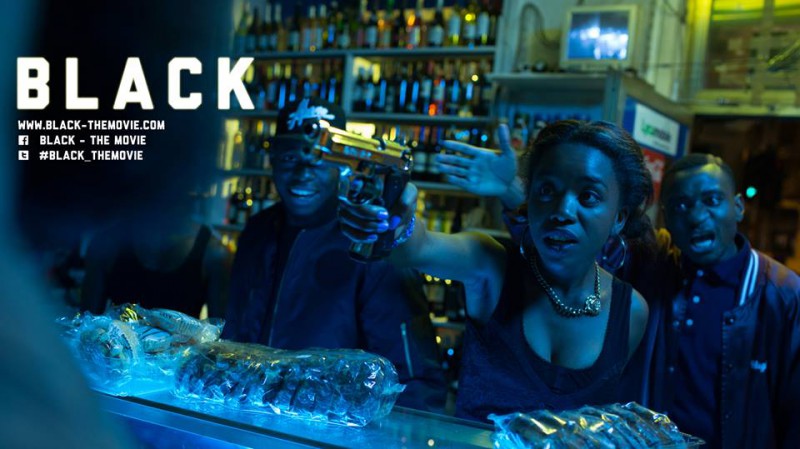
Interpreting Colors at EIFF 2016

Mavela with the Black Bronx.
The meaning of colors and their use influences how scenes, characters, and situations are interpreted in films. Black (2015) a Belgian film directed by Adil el Arbi and Bilall Fallah follows traditional color theory through how they light scenes and select costumes. Alternately, Sparrows (2015) directed by Rúnar Rúnarsson contradicts color theory through its entire mis en scène.
As a modern day retelling of Romeo and Juliet, Black focuses on two opposing gangs in Brussels, the Black Bronx which Mavela (Martha Canga Antonio), the modern Juliet, belongs to and the 1080s of which Marwan (Aboubakr Bensaïhi), the new Romeo, is a member. Throughout the film the Black Bronx is depicted as the worse of the two gangs beginning with the locations they spend the most time in, their apartment and a club they frequent. The Black Bronx’s apartment is dark with minimal decorations as its walls are gray sheeted metal and during the night there is minimal light besides the Christmas tree lights and television. During the day there is only natural light, but it still leaves many shadows in the room. The apartment is the scene of one of the violent rapes in the film and another from before the film’s timeline. Also, the club which the film shows the gang hanging out in late is like any nightclub nearly pitch black with occasionally flashing light. This was the club where the gang extorted money out of a singer in an exchange for not shooting someone during a concert. The darkness of the two locations reinforces the nefarious connotations tied with the dark. Similarly, the costumes of Mavela when she is with Marwan versus when she is with the gang reflect this color pattern. Early in her relationship with Marwan she wears a white flowy dress which alludes to the freedom and innocence she has. Later, the Black Bronx discover her relationship and rape her telling her that she can only be with someone from the crew. After that she wears mostly tight black clothing, but the characters appears trapped and unhappy following with the typical meanings for darkness and light. The darkness surrounds the gang in their clothes and settings.
Comparatively, the 1080s, who are introduced as thieves, do not really have any singular hangout space, but instead they select different spaces around their neighborhood in Brussels. When the gang is shown hanging out the light is always brighter than the Black Bronx’s apartment and they don’t have any walls holding them in. The most violent thing the gang does is throw Molotov Cocktails at a police car after the officers get out. Their lack of a singular location allows the city of Brussels during the day to be their scene, tying in with the idea of light and bright colors being freedom and the only innocence they can claim is in their mostly non-violent crimes and lack of guns. Unlike Mavela, the 1080s do not hurt Marwan and force him to stay with their gang, but he does separate himself from them. However his clothes do not change like Mavela’s, instead he remains in his lightly colored tops with khakis or jeans, but on his dates with Mavela he also wears a white shirt. His white shirt reflects Mavela’s dress which she wore during the time of pure, innocent happiness for the both of them. Black uses basic color theory straightforwardly to emphasize the difference between the two gangs.
Sparrows subverts normal color theory of white as good and pure and safe as some of the most tragic scenes occur in a light scene. The film at first appears to be following common connotations by introducing the main character Ari (Atli Oskar Fjalarsson) in a white church with the angelic voices of boys singing. However, the constant daylight undermines the chance of darkness ever occurring in the film. The first scene that is both tragic and full of light yellows and pale blues is Ari’s sexual assault by Vera (Arndís Hrönn Egilsdóttir) in his room. This is his loss of virginity and the setting of the room continues to almost flaunt how bright it is taunting the association of white and innocence. Then again after Lára (Rakel Björk Björnsdóttir) is raped in the house the bed she is laying in is covered in pure white sheets and the only color comes from her red lipstick and her dark hair. The bed looks like a good and safe place, but little does she know what happened there. This moment which is very dark and could be displayed as such deliberately uses white to show the harmfulness of innocence and how no matter how bright and safe a place can appear horrible events still occur.
Meanings are associated with all sorts of colors which can help to add meaning to a film, such as in Black, or be subverted to add a certain amount of surprise factor.
Comments are closed, but trackbacks and pingbacks are open.